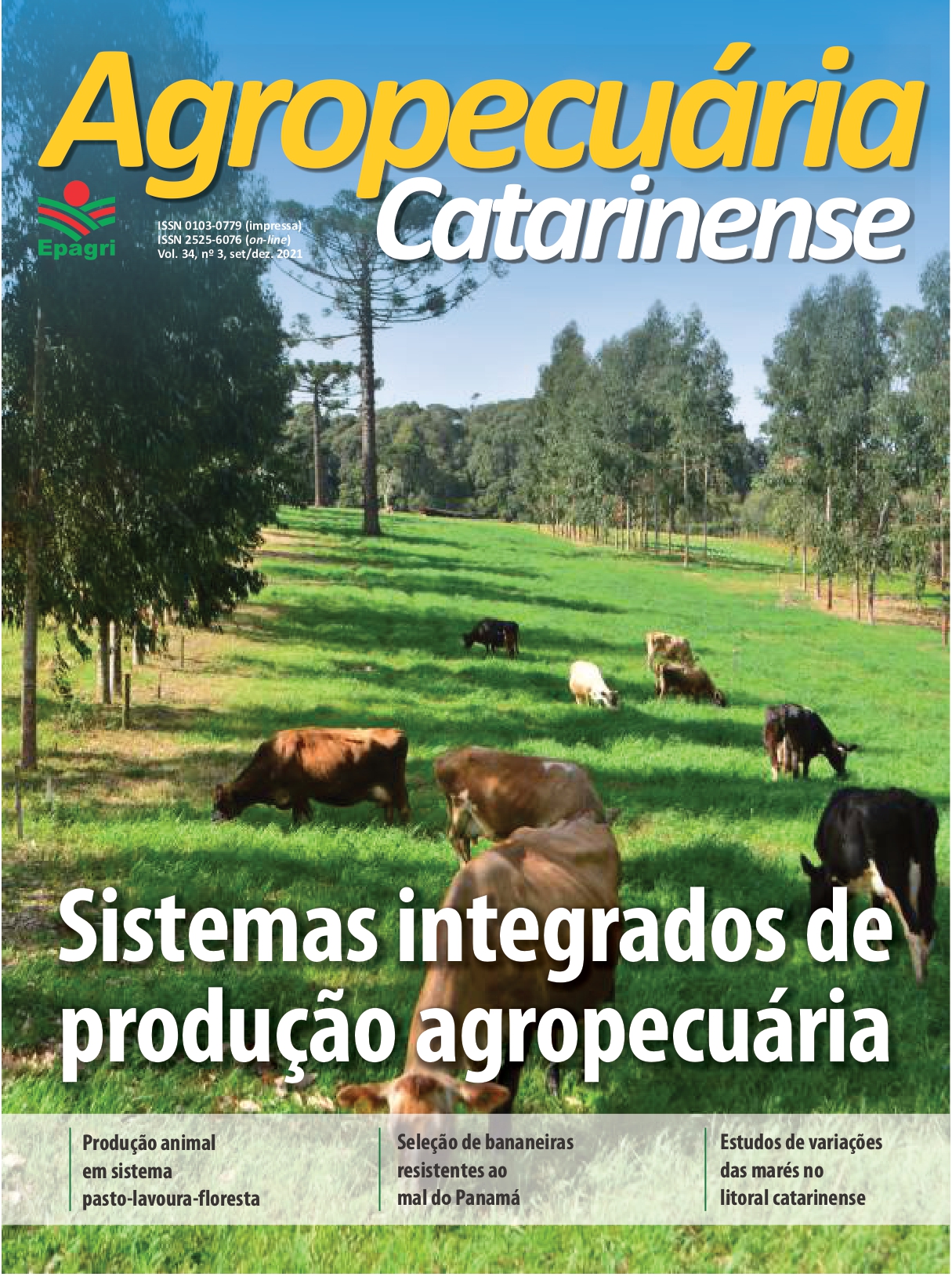Molecular screening in banana germplasm collection to identify sources of resistance to Fusarium oxysporum f. sp. cubense tropical race 4.
DOI:
https://doi.org/10.52945/rac.v34i3.1105Keywords:
Fusarium wilt, SCAR markers, Musa acuminata, Musa balbisianaAbstract
The banana germplasm collection of Epagri- Estação Experimental de Itajaí, Santa Catarina, Brazil, holds 120 banana accessions from different origins, targeting at the conservation and the breeding. One of the main challenges of banana breeding is the selection of plants resistant to Fusarium oxysporum f. sp. cubense. This study aimed to identify, via molecular markers, the plants resistant to tropical race 4 (TR4), which is currently absent in Brazil. The results showed a wide presence of molecular marks associated with resistance to tropical race 4 in the genotypes of the germplasm collection. This information is important for the advancement of the Epagribanana breeding program.
Metrics
Publication Facts
Reviewer profiles N/A
Author statements
- Academic society
- Epagri - Revista Agropecuária Catarinense
- Publisher
- Empresa de Pesquisa Agropecuária e Extensão Rural de Santa Catarina - Epagri
References
EPAGRI. Números da Agropecuária Catarinense. Florianópolis:EPAGRI, 2020. 64p. (Epagri. Documentos, 313).
GARCÍA-BASTIDAS, F.A.; QUINTERO-VARGAS, J.C.; AYALA-VASQUEZ, M.; SCHERMER, T.; SEIDL, M.F.; SANTOS-PAIVA, M.; NOGUERA, A.M.; AGUILERA-GALVEZ, C.; WITTENBERG, A.; HOFSTEDE, R.; SØRENSEN, A.; KEMA, G.H.J. First Report of Fusarium Wilt Tropical Race 4 in Cavendish Bananas Caused by Fusarium odoratissimum in Colombia. Plant Disease, Saint Paul, v.104, n.3, p.994-994, 2020. DOI: https://doi.org/10.1094/PDIS-09-19-1922-PDN.
D´HONT, A.; DENOEUD, F.; AURY, J-M.; BAURENS, F-C.; CARREEL, F.; GARSMEUR, O.; NOEL, B.; BOCS, S.; DROC, G.; ROUARD, M.; SILVA, C.; JABBARI, K.; CARDI, C.; POULAIN, J.; SOUQUET, M.; LABADIE, K.; JOURDA, C.; LANGELLÉ, J.; ROGIER-GOUD, M.; ALBERTI, A.; BERNARD, M.; CORREA, M.; AYYAMPALAYAM, S.; MCKAIN, M.R.; LEEBENS-MACK, J.; BURGESS, D.; FREELING, M.; MBÉGUIÉ-A-MBÉGUIÉ, D.; CHABANNES, M.; WICKER, T.; PANAUD, O.; BARBOSA, J.; HRIBOVA, E.; HESLOP-HARRISON, P.; HABAS, R.; RIVALLAN, R.; FRANCOIS, P.; POIRON, C.; KILIAN, A.; BURTHIA, D.; JENNY, C.; BAKRY, F.; BROWN, S.; GUIGNON, V.; KEMA, G.; DITA, M.; WAALWIJK, C.; JOSEPH, S.; DIEVART, A.; JAILLON, O.; LECLERCQ, J.; ARGOUT, X.; LYONS, E.; ALMEIDA, A.; JERIDI, M.; DOLEZEL, J.; ROUX, N.; RISTERUCCI, A-M.; WEISSENBACH, J.; RUIZ, M.; GLASZMANN, J-C.; QUÉTIER, F.; YAHIAOUI, N.; WINCKER, P. The banana (Musa acuminata) genome and the evolution of monocotyledonous plants. Nature, Basingstoke, v.488, p.213-2017, 2012. DOI: https://doi.org/10.1038/nature11241.
DOYLE, J.J.; DOYLE, J.L. Isolation of plant DNA from fresh tissue. Focus, [S.l.], v.12, p.13-15, 1990.
FU, Y.B. The vulnerability of plant genetic resources conserved ex situ. Crop Science, Hoboken, v.57, n.5, p.2314-2328, 2017. DOI: https://doi.org/10.2135/cropsci2017.01.0014.
LI, W.M.; DITA M.; WU W.; HU G.B.; XIE J.H.; GE X.J. Resistance sources to Fusarium oxysporum f. sp. cubense tropical race 4 in banana wild relatives. Plant Pathology, Oxford, v.6, n.5, p.1061-1067, 2015. DOI: https://doi.org/10.1111/ppa.12340.
MARIESCHI, M.; TORELLI, A.; BEGHÉ, D.; BRUNI, R. Authentication of Punica granatum L.: development of SCAR markers for the detection of 10 fruits potentially used in economically motivated adulteration. Food Chemistry, Amsterdam, v.202, p.438–444, 2016. DOI: https://doi.org/10.1016/j.foodchem.2016.02.011.
PLOETZ, R.C. Fusarium wilt of banana is caused by several pathogens referred to as Fusarium oxysporum f. sp. cubense. Phytopathology, Saint Paul, v.96, n.6, p.653-656, 2006. DOI: https://doi.org/10.1094/PHYTO-96-0653.
PLOETZ, R.C. Fusarium wilt of banana. Phytopathology, Saint Paul, v.105, n.12, p.1512-1521, 2015. DOI: https://doi.org/10.1094/PHYTO-04-15-0101-RVW.
ORDONEZ, N.; SEIDL, M.F.; WAALWIJK, C.; DRENTH, A.; KILIAN, A.; THOMMA, B.P.H.J.; PLOETZ, R.C.; KEMA, G.H.J. Worse Comes to Worst: Bananas and Panama Disease — When Plant and Pathogen Clones Meet. PloS Pathogens, San Francisco, v.11, n.11, e1005197, 2015. DOI: https://doi.org/10.1371/journal.ppat.1005197.
SENASA. Senasa confirma brote de Fusarium Raza 4 Tropical en Piura. Servicio Nacional de Sanidad Agraria del Perú, 2021. Disponível em: https://www.gob.pe/institucion/senasa/noticias/429832-senasa-confirma-brote-de-fusarium-raza-4-tropical-en-piura. Acesso em: 13 maio 2021.
SUTHERLAND, R; VILJOEN, A.; MYBURG, A.A.; VAN DEN BERG, N. Pathogenicity associated genes in Fusarium oxysporum f. sp. cubense race 4. South African Journal of Science, Pretoria, v.109, n.5/6, p.1-10, 2013. DOI: https://doi.org/10.1590/sajs.2013/20120023.
THANGAVELU, R.; LOGANATHAN, M.; ARTHEE, R.; PRABAKARAN, M. UMA, S. Fusarium wilt: a threat to banana cultivation and its management. CAB Reviews, Wallingford, v.15, n.4, p.1-24, 2020. DOI: https://doi.org/10.1079/PAVSNNR202015004.
VAN DEN HOUWE, I.; CHASE, R.; SARDOS, J.; RUAS, M.; KEMPENAERS, E.; GUIGNON, V.; MASSART, S.; CARPENTIER, S.; PANIS, B.; ROUARD, M.; ROUX, N. Safeguarding and using global banana diversity: a holistic approach. CABI Agriculture and Bioscience, Basingstoke, v.1, n.15, p.1-22, 2020. DOI: https://doi.org/10.1186/s43170-020-00015-6.
VIEIRA, M.L.C.; SANTINI, L.; DINIZ, A.L.; MUNHOZ, C.F. Microsatellite markers: what they mean and why they are so useful. Genetics and Molecular Biology, Ribeirão Preto, v.39, n.3, p.312-328, 2016. DOI: https://doi.org/10.1590/1678-4685-GMB-2016-0027.
WANG, W.; HU, Y.; SUN, D.; STAEHELIN, C.; XIN, D.; XIE, J. Identification and evaluation of two diagnostic markers linked to Fusarium wilt resistance (race 4) in banana (Musa spp.). Molecular Biology Reports, Basingstoke, v.39, p.451-459, 2012. DOI: https://doi.org/10.1007/s11033-011-0758-6.
Downloads
Published
How to Cite
Issue
Section
License
Copyright (c) 2021 Gustavo Henrique Ferrero Klabunde, Adriana Pereira, André Boldrin Beltrame, Ramon Felipe Scherer

This work is licensed under a Creative Commons Attribution 4.0 International License.





